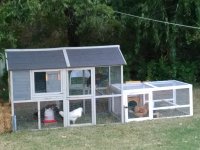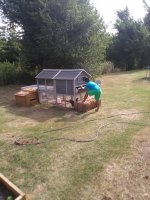I noticed that a lot of people have been asking about integration. Here is how to properly and safely integrate chickens.
You will need a run, or a dog crate (for chicks only or a large one for at least one hen). The run should be covered in hardware cloth. Depending on the size and amount of birds that need integrated, you will need to judge which will work best.
Put the run inside the pen, but if you free range, place the run in a spot where the chickens hang out the most.
When the birds are in the run, be sure to give them entertainment, shelter from the wind, rain, and sun, and of course, food and water. There are pictures at the very bottom that show a great run set up.
For adult chickens:
Once the birds have been in the run no less than a week, you can let them out for a supervised visit with the others. If all goes well, you may decide to leave them out for good. Or you may play it safe and keep the birds in for a few more days. You should do what is best for your flock.
For chicks:
Because chicks are small and delicate, you should put them in the run for much longer, and make sure they have most of their feathers. Keep them in the run until they are a considerable size. As I said above, a supervised visit is the first step. I personally would do many supervised visits and then only leave them out when I am home. This is to prevent the hens from hurting or killing the pullets or from predators. When all seems well, you can begin leaving them out full time.
A few things to remember:
It is better to be safe rather than sorry. Even if you think the new birds will be okay, always observe and if everything is not going smoothly, just put them back in the run.
Watch out for serious pecking. Pecking of new birds should be to establish pecking order, but not to hurt or draw blood.
Make sure the new bird are getting enough food and water. Sometimes the chickens will prevent new or lower birds from eating so always check crops at night.
Don't be afraid to put the birds back in the run if you need to! It is for their safety.
If you have just purchased new birds (not coming from a hatch you have done of your own birds' eggs) make sure to keep that bird quarantined for at least one to two weeks so that you don't bring sicknesses into your flock. If they start to show signs of illness, be doubly careful about touching them and then going outside to your flock. A wire cage or dog crate works very well for quarantineing place.
Here are some pictures of my own run. That is a bunny hutch which I attatch to the open side of the run for sun, wind, and rain protection. The run is 8 by 3 feet. It is designed for my bantam and no more than four chicks/pullet and no more than one full grown hen. Design and and make your run to fit your situation.



To anyone who is integrating good luck, and if you have any questions or things you would like to add, post away! Also if you have any methods of integration please tell me about them!
You will need a run, or a dog crate (for chicks only or a large one for at least one hen). The run should be covered in hardware cloth. Depending on the size and amount of birds that need integrated, you will need to judge which will work best.
Put the run inside the pen, but if you free range, place the run in a spot where the chickens hang out the most.
When the birds are in the run, be sure to give them entertainment, shelter from the wind, rain, and sun, and of course, food and water. There are pictures at the very bottom that show a great run set up.
For adult chickens:
Once the birds have been in the run no less than a week, you can let them out for a supervised visit with the others. If all goes well, you may decide to leave them out for good. Or you may play it safe and keep the birds in for a few more days. You should do what is best for your flock.
For chicks:
Because chicks are small and delicate, you should put them in the run for much longer, and make sure they have most of their feathers. Keep them in the run until they are a considerable size. As I said above, a supervised visit is the first step. I personally would do many supervised visits and then only leave them out when I am home. This is to prevent the hens from hurting or killing the pullets or from predators. When all seems well, you can begin leaving them out full time.
A few things to remember:
It is better to be safe rather than sorry. Even if you think the new birds will be okay, always observe and if everything is not going smoothly, just put them back in the run.
Watch out for serious pecking. Pecking of new birds should be to establish pecking order, but not to hurt or draw blood.
Make sure the new bird are getting enough food and water. Sometimes the chickens will prevent new or lower birds from eating so always check crops at night.
Don't be afraid to put the birds back in the run if you need to! It is for their safety.
If you have just purchased new birds (not coming from a hatch you have done of your own birds' eggs) make sure to keep that bird quarantined for at least one to two weeks so that you don't bring sicknesses into your flock. If they start to show signs of illness, be doubly careful about touching them and then going outside to your flock. A wire cage or dog crate works very well for quarantineing place.
Here are some pictures of my own run. That is a bunny hutch which I attatch to the open side of the run for sun, wind, and rain protection. The run is 8 by 3 feet. It is designed for my bantam and no more than four chicks/pullet and no more than one full grown hen. Design and and make your run to fit your situation.
To anyone who is integrating good luck, and if you have any questions or things you would like to add, post away! Also if you have any methods of integration please tell me about them!
Last edited:



